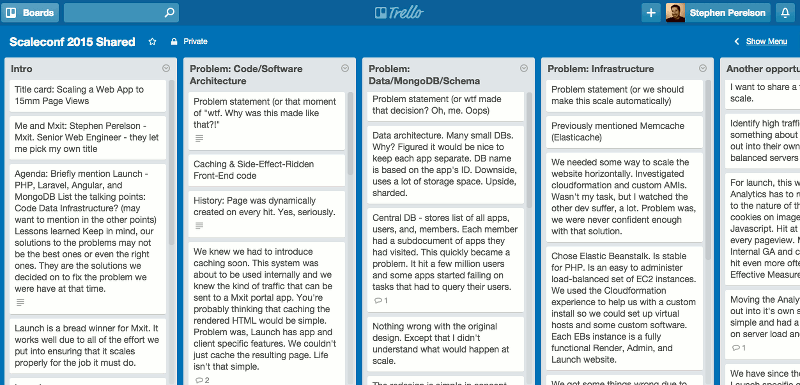Planning a Talk with Trello
I hadn’t spoken publicly for nine years. Not since I was a lecturer. I hadn’t attended any conferences since then either. Not until Scaleconf 2014.
Something strange came over me at Scaleconf 2014. I actually thought that I could speak at this conference and, more importantly, I figured I had something to share. I’m not usually like this. Honestly, I was hoping my talk wouldn’t be accepted. Nobody needs this stress.
As it so happened, my talk proposal was accepted for Scaleconf 2015, which prompted some serious planning. There is nothing like the threat of public embarrassment to make me step up my usual planning and preparation.
Preparations
I decided to do a brain dump of all the bits of information and stories I wanted to talk about. I would have done this step in a very offline way in the past. This time I decided to use a software tool to order my thoughts and to allow me to share my planning with a few colleagues.
I settled on using Trello for this task. I did look at a few alternative board and card style products, but nothing beat the fluidity that Trello offers. It doesn’t hurt that everyone on the team has a Trello account already.
My board layout
I chose to represent my talk as a series of acts where each act is a list on the board. Each act is made up of cards placed in the appropriate order. Each card represents an idea or point of discussion. For example act 1 would be the introduction and the final act would be the final remarks.
I tried to place all of the discussion point’s text into the title of the card so that it would be visible. Notes could be added by colleagues reviewing the cards, which in turn could become conversations that would evolve the talk’s planning.
Keep in mind that the cards on the board for my talk did not directly represent slides in the yet-to-be made slide deck.
Translating into a slide deck
Turning the lists and cards into slides involved identifying key points and assemble these points into possible slides.
It is important to remember that the slide deck does not tell the whole story. Each slide is only a prop to reinforce your message. It is also useful to keep the audiences eyes off you during your talk.
The Trello board and its cards is the whole story to tell while the slides end up being the salient points that help prod you to remember the story when you’re speaking.
My slide deck can be viewed at http://bit.ly/scaleconf_perelson
Practising
I started memorising my talk by reading through the cards on my board. I progressed to spending more time on the slide deck and only referencing the Trello board when necessary.
Eventually, I was not referencing the Trello board anymore. It had served its purpose.
The end result
According to people that shared feedback with me, my talk went well. I attribute this mainly to the hours practising aloud.
Being able to plan out my talk using Trello’s board and cards interface was tremendously useful. I was able to very quickly dump ideas for speaking points into an interface that allowed me to rearrange them into an order that made sense.
If I felt something was not flowing nicely, I could drop a card in to make it flow better. And the same is true for removing cards that no longer helped the story I wanted to tell.
Being able to have a flexible storyboard and to be able to collaborate with colleagues to get guidance was invaluable in my preparation work.
